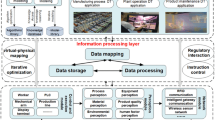Abstract
Increasing competitiveness in engineering industry pressurizes companies to improve productivity of every single element in processes. As a result of this pressure, increasing productivity of design staff and design systems is systematically investigated by industry professionals and researchers. Design reuse appears as an effective approach to increase productivity levels. It has been already used personally by designers consciously or subconsciously. This paper proposes a computer-based design reuse methodology developed with the purpose of efficient corporate memory usage. The paper focused on steel construction infrastructure design process; however, its approach can be easily implemented in different engineering design processes.





Similar content being viewed by others
References
Bai J, Gao S, Tang W, Liu Y, Guo S (2010) Design reuse oriented partial retrieval of CAD models. CAD Comput Aided Des 42(12):1069–1084. doi:10.1016/j.cad.2010.07.002
Benmiled A, Bakhouya M (2013) A framework for knowledge reuse in product design and development process. Int J Metadata Semant Ontol 8(3):206–214. doi:10.1504/IJMSO.2013.057766
Brunsmann J, Wilkes W (2009) Enabling product design reuse by long-term preservation of engineering knowledge. Int J Dig Curation 3(4):17–28. doi:10.2218/ijdc.v4i3.114
Costa CA, Luciano MA, Lima CP, Young RIM (2012) Assessment of a product range model concept to support design reuse using rule based systems and case based reasoning. Adv Eng Inform 26(2):292–305. doi:10.1016/j.aei.2011.11.001
Culley S (1999) Classification approaches for standard parts to aid design reuse. J Eng Manuf 213(2):203–207. doi:10.1243/0954405991517371
Demian P, Fruchter R (2005) Measuring relevance in support of design reuse from archives of building product models. J Comput Civ Eng 19(2):119–136. doi:10.1061/(ASCE)0887-3801(2005)19:2(119)
Demian P, Fruchter R (2006) Methodology for usability evaluation of corporate memory design reuse systems. J Comput Civ Eng. doi:10.1061/(ASCE)0887-3801(2006)20:6(377)
Demian P, Fruchter R (2006) An ethnographic study of design knowledge reuse in the architecture, engineering, and construction industry. Res Eng Des 16(4):184–195. doi:10.1007/s00163-006-0010-x
Demian P, Fruchter R (2006) Finding and understanding reusable designs from large hierarchical repositories. Inf Vis 5(1):28–46. doi:10.1057/palgrave.ivs.9500114
Efthymiou K, Sipsas K, Mourtzis D, Chryssolouris G (2015) On knowledge reuse for manufacturing systems design and planning: a semantic technology approach (2015). CIRP J Manuf Sci Technol 8:1–11. doi:10.1016/j.cirpj.2014.10.006
Fruchter R, Demian P (2002) CoMem: designing an interaction experience for reuse of rich contextual knowledge from a corporate memory. Artif Intell Eng Des Anal Manuf 16(3):127–147. doi:10.1017/S0890060402163025
Girczyc E, Carlson S (1993) Increasing design quality and engineering productivity through design reuse. In: Proceedings of the 30th ACM/IEEE design automation conference, Dallas, pp 48–53. doi:10.1145/157485.164565
Gray PMD, Runcie T, Sleeman D (2015) Reuse of constraint knowledge bases and problem solvers explored in engineering design. Artif Intell Eng Des Anal Manuf 29(1):1–18. doi:10.1017/S0890060414000134
Huang Y, Jiang Z, He C, Liu J, Song B, Liu L (2015) A semantic-based visualised wiki system (SVWkS) for lesson-learned knowledge reuse situated in product design. Int J Prod Res 53(8):2524–2541. doi:10.1080/00207543.2014.975861
Huang C-C, Chuang H-F, Chen S-Y (2016) Corporate memory: design to better reduce, reuse and recycle. Comput Ind Eng 91:48–65. doi:10.1016/j.cie.2015.10.016
Ren Z, Anumba CJ, Yang F (2013) Development of CDPM matrix for the measurement of collaborative design performance in construction. Autom Constr 32:14–23. doi:10.1016/j.autcon.2012.11.019
Shah JJ, Jeon DK, Urban SD, Bliznakov P, Rogers M (1996) Database infrastructure for supporting engineering design histories. Comput Aided Des 28(5):347–360. doi:10.1016/0010-4485(95)00054-2
Sundaravadivelu S, Vaidyanathan A, Ramaswamy S (2014) Knowledge reuse of software architecture design decisions and rationale within the enterprise. In: Proceedings of the 2014 international conference on issues and challenges in intelligent computing techniques, ICICT 2014, Art. No. 6781289, pp 253–261. doi:10.1109/ICICICT.2014.6781289
Tan HC, Carrillo PM, Anumba CJ, Bouclaghem N, Kamara JM, Udeaja CE (2007) Development of a methodology for live capture and reuse of project knowledge in construction. J Manag Eng 23(1):18–26. doi:10.1061/(ASCE)0742-597X(2007)23:1(18)
Yu J, Cha J, Lu Y (2012) Design synthesis approach based on process decomposition to design reuse. J Eng Des 23(7):526–543. doi:10.1080/09544828.2011.629316
Zhang X, Peng G, Hou X, Zhuang T (2014) A knowledge reuse-based computer-aided fixture design framework. Assem Autom 34(2):169–181. doi:10.1108/AA-04-2013-033
Author information
Authors and Affiliations
Corresponding author
Rights and permissions
About this article
Cite this article
Gunduz, M., Yetisir, T. A design reuse technology to increase productivity through automated corporate memory system. Neural Comput & Applic 29, 609–617 (2018). https://doi.org/10.1007/s00521-016-2586-z
Received:
Accepted:
Published:
Issue Date:
DOI: https://doi.org/10.1007/s00521-016-2586-z




